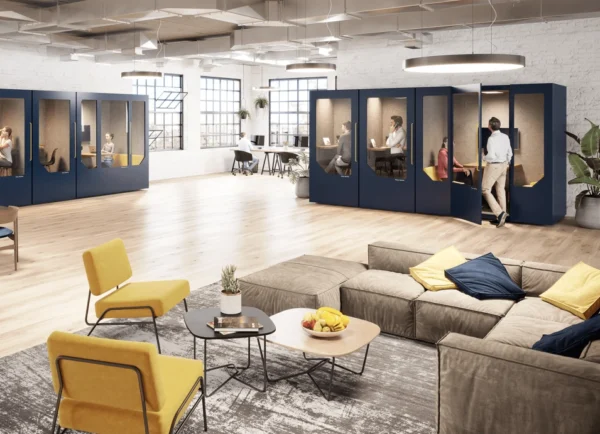Why Every Modern Workplace Needs a Phone Booth
Office workers spend a substantial part of their day making and receiving phone calls. While these conversations are essential to workplace communication, maintaining privacy and professionalism amid the ambient noise of an open-plan office can be a challenge.
A study by Humboldt University in Berlin found that after a disruption in concentration, it may take up to 23 minutes to fully refocus—hardly ideal when you’re on an important call with a client or colleague.
The Open-Plan Dilemma: Enter the Phone Booth
Perhaps the biggest casualty of the open-plan layout is privacy. How can employees discuss confidential matters in a space that resembles a busy café? The solution is simple and effective: the Phone Booth.
Phone Booths—also known as Office Phone Booths—are self-contained units designed to sit seamlessly within open-plan layouts. Taking inspiration from the classic telephone box, these modern booths are reimagined for professional settings. They’re an ideal alternative to building expensive meeting rooms, offering a way to maximise space and productivity without costly renovations.
The Benefits of Installing Office Phone Booths
🔒 Privacy
Office Phone Booths create a secluded space for private phone calls, video meetings, or confidential conversations. This prevents sensitive discussions from being overheard in a noisy workspace.
🔇 Noise Reduction
In open offices, background chatter and keyboard clatter can make it hard to concentrate. Phone Booths provide a quiet haven, helping employees stay focused and productive.
📞 Communication Flexibility
No more ducking into stairwells or hallway corners. Office Phone Booths let team members take or make important calls without leaving the premises or causing disruption.
🤝 Improved Collaboration
Though primarily used for individual privacy, larger Office Phone Booths or meeting pods can also serve as intimate spaces for quick team discussions or brainstorm sessions.
💻 Support for Hybrid Work
With the rise of remote and hybrid working, Phone Booths give employees a professional backdrop and soundproof environment for video calls, regardless of their in-office schedule.
⚡ Multifunctional Features
Today’s Office Phone Booths are equipped with modern conveniences—USB ports, charging stations, whiteboards, and more. They’re not just quiet corners—they’re productivity hubs.
🎨 Aesthetic Appeal
Beyond functionality, these booths come in a range of styles and finishes to enhance your office’s visual identity. From sleek minimalist designs to cozy upholstered interiors, there’s a Phone Booth for every brand.
Potential Drawbacks of Office Phone Booths
While the benefits are compelling, it’s important to consider potential challenges:
-
Limited Space: Most Office Phone Booths are built for solo use or very small groups.
-
Demand & Scheduling: In high-traffic offices, booth availability can become a bottleneck.
-
Cost: Quality Phone Booths are an investment—not just in purchase, but also installation and maintenance.
-
Tech Compatibility: As communication tools evolve, older booths may need upgrades.
-
Space Considerations: Even compact booths take up floor space, which could be tight in smaller offices.
Despite these factors, the value of a well-placed Office Phone Booth often outweighs the costs, especially when chosen with workplace needs in mind.
Why Office Phone Booths Support the Future of Work
🌐 Hybrid Work Is Here to Stay
Private spaces like Phone Booths support the growing hybrid workforce by offering soundproof environments for virtual collaboration.
😌 Focus on Wellbeing
A comfortable Office Phone Booth doubles as a mental break zone—a place to regroup or unwind with a little privacy.
💡 Tech Integration
Smart Phone Booths come with everything from acoustic panels to integrated AV tech, boosting efficiency and the user experience.
Office Pods: The Modern Alternative to Meeting Rooms
Traditional meeting rooms are great—if you can find one. In flexible or rented spaces, building permanent rooms can be expensive and impractical. Office Pods offer a sleek, movable, and reconfigurable solution.
These four-sided, enclosed structures are fully self-contained, often featuring lighting, ventilation, and optional furnishings. They’re customisable in a variety of finishes, from easy-clean laminates to plush upholstery, making them a perfect complement to Phone Booths in the modern workspace.
Conclusion: Whether you’re looking to reduce noise, enhance privacy, or simply make your office feel more high-functioning, Phone Booths and Office Phone Booths are game-changers. They’re not just a trend—they’re a strategic tool for creating a productive, balanced, and future-ready work environment.
For all your pod needs we provide high quality work pods, acoustic pods & portable meeting rooms, throughout the UK. My Office Pod UK believes that the best office meeting pods should be available to everyone and have selected what we see as the best pods on the market to show you.
Want to learn more?Contact us or Call us






